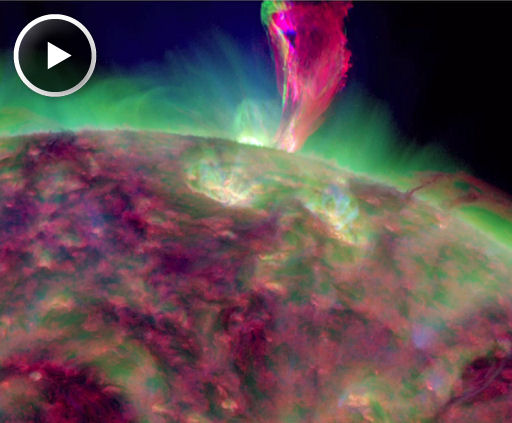SOMETHING IN THE OFFING: A potentially significant active region is about to rotate onto the Earthside of the sun. A hot plume of plasma flying over the sun's northeastern limb heralded its approach during the early hours of April 15th:
Extreme UV image credit: NASA's Solar Dynamics Observatory
The eruption hurled a coronal mass ejection toward NASA's STEREO-B spacecraft. Analysts at the Goddard Space Weather Lab have prepared a forecast track showing the progress of the cloud. No planets are in the line of fire.
Stay tuned for updates as the sun turns to reveal the active region in the days ahead. Solar flare alerts: text, phone.

![]()
Solar wind
speed: 365.5 km/sec
density: 0.0 protons/cm3
explanation | more data
Updated: Today at 1635 UT
![]()
X-ray Solar Flares
6-hr max: B5 1157 UT Apr16
24-hr: C1 0047 UT Apr16
explanation | more data
Updated: Today at: 1600 UT
![]()
![]()
![]()
Daily Sun: 16 Apr 12
![]()
![]()
Sunspot 1459 is large, but its magnetic field is simple, posing little threat for strong flares. Credit: SDO/HMI
![]()
![]()
![]()
Sunspot number: 77
What is the sunspot number?
Updated 15 Apr 2012
Spotless Days
Current Stretch: 0 days
2012 total: 0 days (0%)
2011 total: 2 days (<1%)
2010 total: 51 days (14%)
2009 total: 260 days (71%)
Since 2004: 821 days
Typical Solar Min: 486 days
Updated 15 Apr 2012
The Radio Sun
10.7 cm flux: 102 sfu
explanation | more data
Updated 15 Apr 2012
![]()
![]()
![]()
Current Auroral Oval:
![]()
Switch to: Europe, USA, New Zealand, Antarctica
Credit: NOAA/POES
![]()
![]()
![]()
Planetary K-index
Now: Kp= 2 quiet
24-hr max: Kp= 2 quiet
explanation | more data
![]()
Interplanetary Mag. Field
Btotal: 3.0 nT
Bz: 0.1 nT south
explanation | more data
Updated: Today at 1637 UT
![]()
![]()
![]()
Coronal Holes: 16 Apr 12
![]()
![]()
There are no large coronal holes on tthe Earthside of the sun. Credit: SDO/AIA.





